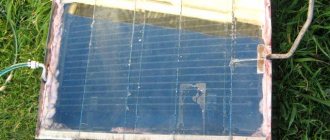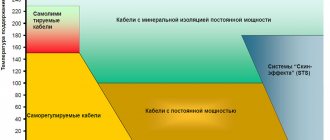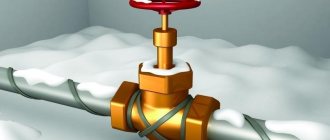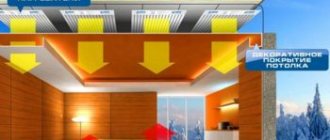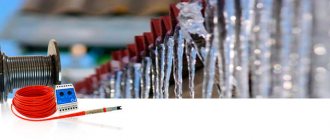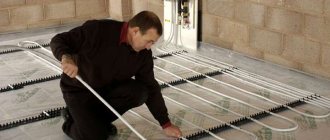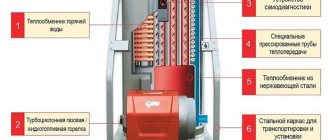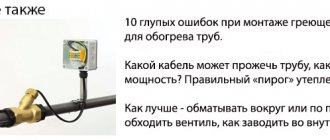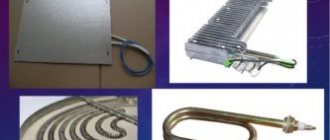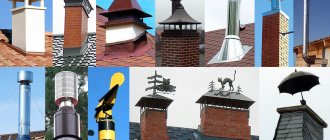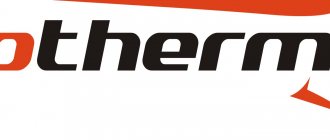Technological solutions for installing heated floors have been supplemented with a new development that allows for “smart” heating using electric current. A self-regulating heating cable has a thermistor layer in its design, which reduces heating of the element as the temperature rises.
This design allows you to save electricity by heating the surface only where it is needed. If the floor surface is heated evenly, then the heating element consumes a minimum amount of electric current.
If in one of the sectors there is a decrease in temperature, for example, due to spilled cold water, then local heating of only this area occurs. All of the above advantages are overshadowed by one significant disadvantage - the high cost of the cable.
This disadvantage will decrease over time as more self-regulating heating cable manufacturers enter the market. In addition, the difference in cost, during long-term operation, is fully paid off due to the cost-effectiveness of such technology.
Heating of engineering systems: problems and difficulties
Let's figure out what factors make private developers and professional builders sad when it comes to electrical heating of utilities:
- High electricity costs are inevitable when operating most heating cables.
- The risk of purchasing short-lived products of questionable quality.
- Problems with ensuring the tightness of communications (well known to those who have at least once installed a cable inside main pipelines).
In addition to the above: the lack of suitable standard sizes when purchasing a cable forces developers to overpay for extra linear meters. If a person purchases a cable for cutting, he inevitably has to spend time and money searching for missing components (cuffs, cable entries, etc.).
Now let's look at how the Heatus heating cable solves these and other problems.
What are the differences between self-regulating and resistive heating cables?
Answers:
Boris Bogdanov
25.02.2019
A resistive cable has a fixed linear power value; its heating element is a constant resistance in the form of a copper core with special impurities. At low temperatures the cable does not change its power.
A self-regulating cable has the ability to change its power; its heating element is a nonlinear resistance (“matrix”). At a temperature of +10 degrees it consumes 30 W, at a temperature of 0 degrees in melt water it consumes 40 W, at a temperature below zero - more than 40 W.
Comparison of resistive and self-regulating cable. Advantages and disadvantages
| Criterion | Resistive cable | Self-regulating cable |
| Local overheating where the cable strands overlap | The cable maintains constant power along its entire length => it overheats at the point of overlap, which causes rapid aging and destruction of the cable material in this place | Reduces power consumption in overlap areas due to the properties of the “matrix” |
| Starting currents | Initial currents exceed the rated value by 10-15% => automatic according to rated parameters | Initial currents exceed the rated value by 2 times => automation is selected according to start-up parameters => increased cost of the heating control panel |
| Resistance to mechanical stress (step pressure, bending, twisting, etc.) | Severe deformation of the cable leads to deformation of the core in the direction of reducing the cross-sectional area of the conductor, due to which the resistance in this place decreases and local overheating is formed | Deformation of the “matrix” does not affect the operation of the cable |
| Maximum length | By varying the resistance of the heating core, it is possible to achieve large lengths; the resistance is connected in series | A self-regulating matrix is installed between the cores, which have a finite cross-section and corresponding current limitations; if the section is long, the cores of the heating cable on the cold end side overheat and the matrix material peels off from the copper conductor => the cable locally fails |
| Roof heating (snake) | Thanks to its round cross-section, it can be easily unfolded | The cable has the shape of a tape, due to which, when frequently laid, the cable lies on the edge, which is less efficient |
| Roof heating (gutters) | Dirt accumulating in the gutters envelops the cable, resulting in “locked-in” heat and local overheating | Thanks to the self-regulating effect, the cable locally reduces power and “locking in” heat does not occur |
| Roof heating (drainpipes) | High probability of crossing cable strands, blocking heat due to accumulated debris => overheating | The intersection of threads does not provoke overheating and is resistant to heat “locking” |
| Heating of sites | Constant power => stable heating even in extreme conditions (at very low temperatures) | At low temperatures, it releases more power => heating occurs faster. Extreme conditions (very low temperature) => extremely high values of inrush current can provoke detachment of the “matrix” from the current-carrying core => the cable goes out of working condition (reduction in the linear power of the cable) |
| Tank heating | Constant power => stable heating in any conditions, stable maintenance of a positive temperature, high temperature class, for any purpose | Simple layout on any shape due to the possibility of crossing cable threads. Thanks to the self-regulation effect, temperature is maintained with greater static (regulator error). |
| Pipeline heating | Unique object configurations => lack of required length (since the section length is fixed). | The cable is cut, so it easily covers any shape, any configuration of the heated object |
| Durability | There are a large number of conditions for local overheating to occur, but with proper installation and care, the cable can last up to 20 years or more. | It does not have overheating properties, but the resource of the matrix material limits the cable service life to 10 years (there are exceptions, for example, the Fujikura self-regulating cable has a service life of up to 20 years or more). |
“Smart” matrix as a guarantee of efficient energy consumption
Experts know that the main element of a self-regulating heating cable is its matrix. This material, made on the basis of semiconductors, is capable of changing its resistance depending on the temperature in a specific section of the electrical circuit.
The Heatus matrix is made using the most advanced technologies. The manufacturer, of course, does not reveal their secret, but proudly reports the results of their implementation into production practice. Thanks to its technological features, the Heatus matrix demonstrates minimal resistance precisely at low temperatures. As a result, the Heatus cable is ideal for working in low temperature environments where there are power limitations. It consumes a relatively small starting current, so even at the moment of starting, the energy consumption level is very low.
As the temperature rises, the working matrix automatically reduces power consumption. This guarantees energy savings without loss of functionality, and also allows you to equip the system with protective automatics of a lower rating.
Cable selection
In order to purchase a high-quality heating element, you need to familiarize yourself with the most common mistakes that are made when purchasing these products.
Purchasing the cheapest cable
To reduce costs, many manufacturers use low-quality materials to produce the self-regulating element. As a result, such a heating wire is sold at a very low price, which attracts many thrifty buyers who will have to select a cable again in 1–2 years due to the failure of the installed electrical product.
To replace the heating element, it is necessary to dismantle the heated floor, which further increases costs.
Therefore, a stingy buyer of a self-regulating heating cable will pay twice the cost of a high-quality, but more expensive product.
Cable selection by power
Each product that consumes electricity does not use 100% of the power supplied to it, but a small part necessary to perform work or generate heat. The maximum power of the self-regulating element is 150 W/m can only be used in a heated floor system, which is the only heating device in the room.
If this device is used as an additional heat source, then the installed maximum power heating system will waste electricity, while producing more heat than necessary.
In addition, in the production of high-power cables, more expensive materials are used, which cannot but affect the final cost of the product.
If a heating device is used to prevent icing of underground communications, then in this case a power of 60 W/m is sufficient. When equipping the roofs of buildings with self-regulating wire to prevent the formation of icicles, there is also no need to use an overly powerful product.
Heating cable testing
Test date: April 15, 2021 (Quality Management Department, Young Chang Silicone).
The comparison test was carried out on models of the same power (16 W/m).
| No | Company | Matrix model | Resistance, Ω | Test 1 Starting current, A | Test 2 Current, A (after 5 min.) | X times change |
| a | HEATUS | 16GSR2 | 1,825 | 0.145 | 0.037 | 3.9 |
| b | FINE KOREA | SRF16 | 2,003 | 0.135 | 0.052 | 2.6 |
| c | E&S TEC | EHL16 | 1,469 | 0.169 | 0.042 | 4.0 |
| d | RAYCHEM | 16KHP2 | 620 | 0.343 | 0.038 | 9.0 |
| e | HEAT-TRACE | 17FSLE2 | 1,741 | 0.213 | 0.049 | 4.3 |
Rice. 1. Testing the current consumption of cables from various manufacturers.
As the tests show, the inrush current of the Heatus matrix is lower than the average values identified when testing similar products from other manufacturers. During operation, automatic heating systems are repeatedly switched off and restarted; therefore, minimizing starting currents plays a decisive role in ensuring their efficiency.
Another parameter that affects the efficiency of a heating cable is the period of time during which its matrix is able to reach its operating characteristics. Tests have shown that the Heatus cable reaches operating power in the same amount of time as it does for products from other well-known manufacturers.
Rice. 2. Reduction of power as temperature rises.
What does this quality give in combination with low inrush currents? Thanks to it, the Heatus matrix becomes the most promising solution for the construction of “anti-freeze” utilities. How does this affect savings? To be specific: in ten minutes of operation, the Heatus heating cable spends 1.33 W/h (per meter of cable) less electrical power than its analogues, which have similar functionality but are more expensive. Multiply this by the total length of communications of an average facility: the energy savings will be 400 Wh. The characteristic is average, but gives the consumer an objective understanding of their own benefits.
How to choose a suitable self-regulating wire
We talked about the principle of operation of a self-regulating heating cable. Let's move on to the next section - we will tell you how to choose a heating wire based on power. For installation inside and outside the pipe, we will use low-temperature samples that heat up to a maximum of +60 degrees. When calculating the heating cable, focus on the following indicators:
It is the number of conductive paths in a cable that affects its maximum output power.
- Internal arrangement when pipes pass underground - the optimal power is 5 W per linear meter;
- External location when pipes pass underground - depending on the depth, you can use samples with a power of 10-15 W/m;
- Any location for outdoor pipes - choose a thin heating cable with a power of 20-30 W.
The low-temperature heating self-regulating cable for protecting pipelines from freezing is thin and flexible, so it can be wrapped around water supply pipes without any problems.
Let's now see how long a self-regulating heating cable can be cut. We have already said that its length is an arbitrary indicator. But there are still some restrictions. The maximum recommended length is 80-100 meters, the minimum is 20-30 cm . As for the bending radius, it ranges from 6 diameters.
The cost of a self-regulating heating wire depends on its power, the range is quite large. For example, the price per meter of heating cable 30GSR2 with a power of 30 W/m is about 210-230 rubles. And the 16GSR2 modification with a power of 16 W will cost 180-190 rubles/m. You can buy it in plumbing and heating stores in your city, including construction hypermarkets.
Reliability and durability
The heat treatment technology of the Heatus matrix and nickel-plated copper conductor increases the service life of the self-regulating cable, ensuring a reliable connection of the matrix with the current-carrying conductors. In comparison with tin coating, which is used by manufacturers of similar products, this solution looks more promising, reliable and durable. Unlike similar products of lower quality, the service life of which is 1...3 years (maximum), the estimated service life of the Heatus self-regulating cable is 10...20 years. The ability of the Heatus cable to maintain its performance characteristics over a long period of operation is clearly confirmed by appropriate tests (Fig. 3).
Rice. 3. Power density testing after long-term operation.
As tests have shown, after 5200 hours of normal operation (switching on, warming up and switching off), the rated power of the Heatus matrix has changed very little.
Completeness and footage
Agree that any system looks much more profitable and practical if it is delivered to the consumer fully equipped. If we talk about heating systems, then this is better than buying a separate cable, and separately couplings and seals, which are not always of good quality, and which then have to be adjusted to the size of your communications.
Cable products based on the Heatus heating matrix are initially equipped with everything necessary for quick and easy installation. Thus, PerfectJet heating cable kits, designed for installation inside pipes (sewage, water, etc.), in addition to heating elements, are equipped with a cable gland.
A cable gland is a set of parts and elements that ensure hermetically sealed cable fixation in the pipeline. One hundred percent tightness of Heatus kits is ensured by a special form of seal, as well as a large contact area between the cuff and the cable.
And a couple more important points: Heatus installation kits include cables of different lengths (a total of 65 standard sizes, multiples of one meter). For the buyer, such an assortment means the availability of optimal solutions for all occasions. Now, as for safe transportation: neat cardboard packaging will protect the product from damage during transportation, which is very important, because the consequences of mechanical shocks and invisible scratches will certainly manifest themselves during operation.
Self-regulating cable
A self-regulating heating cable is used when it is necessary to maintain the desired water temperature and protect the system from freezing. It is mainly used in hot water supply systems. This type of cable is also used in the construction of storm sewers. It is installed under roof canopies and in gutters. In these cases, it is used to remove excess snow and icicles.
Reliable and environmentally friendly insulation
Insulation based on a high-molecular polymer compound (polyolefin) reliably protects the heating part of Heatus kits for outdoor installation ARDpipe from a variety of mechanical influences: from impacts, repeated kinks, and so on. Thanks to this quality, the ARDpipe cable is a simple tool for solving complex problems: it can protect against freezing and extend the life of engineering systems laid in complex and problematic soils. Heatus outdoor cable is designed for heating utility lines made of various materials. The maximum diameter of the serviced pipeline is 200 mm.
The self-regulating cable, which is included in the PerfectJet work kits, was specially designed for internal installation (for installation inside utility lines). These products are additionally coated with a protective food coating, which is impossible not to note when considering the distinctive characteristics of PerfectJet kits. Very often, such a conductor is used to heat water mains, and the presence of a food casing in this case is a logical requirement of sanitary and environmental standards. The food casing from Heatus reliably covers the markings applied to the cable, which distinguishes the products of this brand from analogue products in which the markings are applied on top of the food casing.
Additional benefits
To purchase a truly high-quality and certified product, a buyer living somewhere in the periphery is usually forced to travel many kilometers. The issue of purchasing a Heatus heating cable is solved much easier: the supplier’s developed dealer network has a wide coverage. At the same time, the manufacturer is open to cooperation with new business partners, offering them favorable and attractive conditions.
Also, every retail customer can purchase Heatus products through the online store - this is the optimal solution for those who are far from the company’s official representatives. Buying online, delivery by popular transport companies and the ability to purchase a heating cable of suitable length and power are advantages that are difficult to overestimate.
Let's sum it up
The uniqueness of the Heatus technical solution lies in the guaranteed savings for the end consumer. Savings at the time of purchase, as well as optimization of operating costs, is what everyone gets, regardless of their region of residence and their current needs. If we add to this the maximum set of kits, we get a budget, but at the same time effective, and durable solution, in which every millimeter of the heating cable works only when it is really needed.
Subscribe to our Telegram channel Exclusive posts every week
The type of outer sheath of the heating cable depends on the scope of its application.
- The polyolefin sheath is used in a self-regulating heating cable for household use for laying under thermal insulation.
- The fluoropolymer sheath is used in cables that are suitable for use in chemically aggressive environments, as well as inside pipelines and drinking water tanks.
- The shell with protection from UV radiation contains UV absorbers, usually fine soot particles (at least 2%), which protect the polyolefin from decomposition under the influence of solar radiation. More details
Polyolefin sheathed cable
Fluoropolymer cable
UV protected cable
